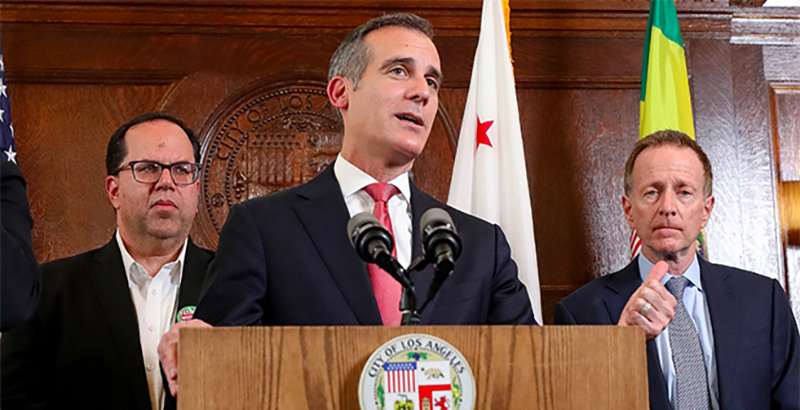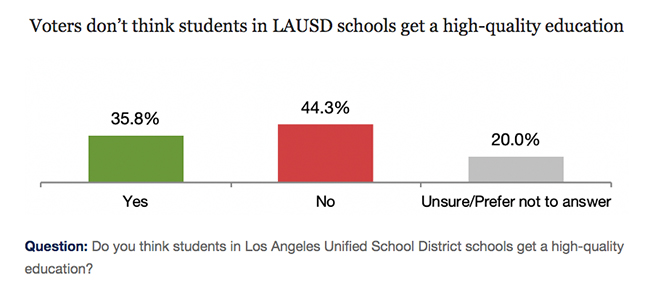Los Angeles Voters Roundly Defeat $500M Annual Parcel Tax, Leaving Nation’s Second-Largest School District on Shaky Financial Footing

This article was produced in partnership with LA School Report.
Los Angeles voters decisively defeated a parcel tax that would have sent $500 million a year to schools, according to unofficial results by the county registrar.
Measure EE, which would have charged residents within L.A. Unified boundaries 16 cents per square foot of developed property for 12 years, fell more than 20 percentage points below the 66.7 percent voter threshold required for the tax to pass. About 45.7 percent of the 304,321 voters who cast ballots as of Tuesday night approved the measure, while 54.3 percent opposed.
Voter turnout stood at 12.2 percent of the district’s 2.5 million registered voters — slightly above average for special elections and surpassing last month’s school board race.
As the polls closed Tuesday night, United Teachers Los Angeles President Alex Caputo-Pearl told a group of parcel tax supporters in Boyle Heights that Measure EE marked a win for public education whether it passed or failed. “The city of Los Angeles is talking about what it, as the city, can do for public schools,” he said.
L.A. Unified — along with UTLA — had touted the tax as indispensable for securing the lower class sizes and additional nurses, counselors and librarians promised in this winter’s $840 million teacher contract, which district officials say is unsustainable with current revenue levels. Opponents of the tax cited concerns about poor accountability and oversight of taxpayer money.
“Achieving a two-thirds vote is a high bar for a reason, but the fact that we got 54 percent of the vote just shows how thoroughly wrong Measure EE was,” Matt Klink, a spokesman for the Vote No on EE campaign, told LA School Report Wednesday morning.
The district now has to send its 2019-20 budget to county overseers by July 1 — without a new local revenue source. The county has threatened a takeover if L.A. Unified can’t prove its solvency over the next three years. District projections show L.A. Unified spending $577 million more than it will take in next year alone and falling some $700 million in the red by 2021-22.
Debra Duardo, Los Angeles County’s superintendent of schools, wrote in a statement to LA School Report Wednesday that the LA County Office of Education “is disappointed” that Measure EE did not pass. “Put simply, LAUSD needs to stop spending more than it receives from the state and federal government,” the statement read, adding that “The County Office team is committed to continuing to work with LAUSD as they develop the district budget for 2019-20.”
Although L.A. Unified anticipates millions in savings through reductions in central office and health care costs, Measure EE’s defeat leaves the district on shaky financial footing as it prepares for the next school year.
What happened?
Passing Measure EE was always an uphill battle.
Parcel taxes aren’t commonplace. Only about 9 percent of school districts — most clustered in the Bay Area — have passed or renewed parcel taxes in the past five years. Measure EE would have been L.A. Unified’s first parcel tax. The only other one that made it to the ballot failed in 2010. Parcel taxes are unique to California, primarily serving as a fallback for cash-strapped districts that aren’t getting enough funding from the state.
Measure EE proponents hoped the car honks, picketing and social media love that marked January’s six-day teacher strike would translate to an outpouring of support for the tax. February polling had found that more than 80 percent of respondents saw some level of need for more investment in L.A. Unified. “Residents and voters are more inclined to support the school district today than any time in the past,” Fernando Guerra, a Loyola Marymount University professor, told LA School Report last month.
The “Yes on EE” campaign had enjoyed high-profile backing from Mayor Eric Garcetti — an instrumental figure in getting the teacher contract approved — and at least four Democratic presidential candidates. It out-fundraised the opposing “No on EE” campaign almost 5 to 1, with more than $9.3 million in outside expenditures, according to city ethics commission data.
But it wasn’t enough to convince residents who didn’t trust the district to be a good steward of the parcel tax money.
There was ample skepticism that the $500 million flowing into L.A. Unified’s general fund annually would be spent on ballooning employee pension and health care costs instead of in the classroom. There was dissatisfaction with the proposed nine-member independent oversight committee, which was outlined in a school board resolution that critics said could have been easily ignored. And there was frustration with low achievement scores in the district despite taxpayers’ past investments — five construction bonds totaling $20.6 billion since 1997, for example. The Measure EE tax would have cost most homeowners between $100 and $450 per year.
https://twitter.com/ridgeley/status/1136257181915918339
In a recent poll of 400 L.A. Unified potential voters, 44.3 percent said they didn’t think district students “get a high-quality education.” About 36 percent said they did.

“We could give them $500 million a year or $5 billion a year, and they still have no plan on how to fix themselves,” Valley Industry and Commerce Association President Stuart Waldman told LA School Report in April.
Legal challenges during the campaign further muddied the water. The Howard Jarvis Taxpayers Association in early May filed a lawsuit claiming that Superintendent Austin Beutner had altered the parcel tax language after the school board approved it — a change that the organization believed could subject a larger proportion of residents’ properties to the tax.
The same organization also filed a complaint in late May alleging that L.A. Unified’s Measure EE advertisements broke campaign finance rules.
What’s next?
L.A. Unified by July 1 must submit its 2019-20 budget to the county. That budget needs to show the district with a “rainy day” minimum reserve of at least 1 percent of its total expenditures for each of the next three years. If it doesn’t, the county has said it would consider installing a fiscal adviser with “stay and rescind power.” This means he or she could rewrite budgets and overturn school board decisions — but could not change union contracts.
Less immediately, the district will now also have to find another avenue for covering the third year of the teacher contract, which is slated to cost $228 million.
Chief Financial Officer Scott Price told the school board in March that “we need to increase revenues.” While Measure EE was L.A. Unified’s most immediate shot at new funding, the district has been trying to save money. Its planned central office reductions will save $85.8 million over two years, and a newly implemented Medicare plan will shave $50 million a year off L.A. Unified’s more than $1 billion yearly health care bill. The district is anticipating some extra funding as well from Gov. Gavin Newsom’s state budget, though that budget isn’t final yet.
L.A. Unified will also once again ask the state to waive a $105 million penalty on districts that have too many administrators compared with teachers, and pursue potential real estate sales or leasing opportunities that could generate $100 million, Price noted at the March board meeting.
Jackie Goldberg, the newest board member, told LA School Report before her election that reviewing the budget was one of her top priorities. “I’m going to sit down with the budget folks and tell them what I understand the budget to be and hear what they think it is, so that we can begin to reconcile some of the differences of opinion about what state the budget’s in,” she said.
L.A. Unified could try for another parcel tax down the line. If it’s during a main election year, like 2020, voter turnout could be higher. There is also a statewide “Schools and Communities First” split roll tax initiative on the ballot in November 2020. If approved by voters, it would tax commercial and industrial property according to their market value, raising an additional $6 billion to $10 billion a year, according to the Legislative Analyst’s Office. An estimated $1.4 billion would be allocated to K-12 schools and community colleges in L.A. County.
“We’re going to keep going forward” if we fail on EE, Beutner had told LAist before Tuesday’s vote. “Because we have the broadest, deepest, most diverse coalition in support of public education in a generation.”
Get stories like these delivered straight to your inbox. Sign up for The 74 Newsletter

;)

